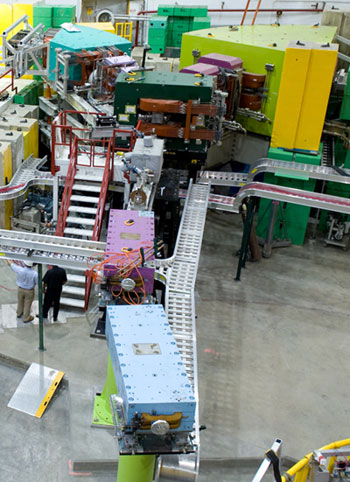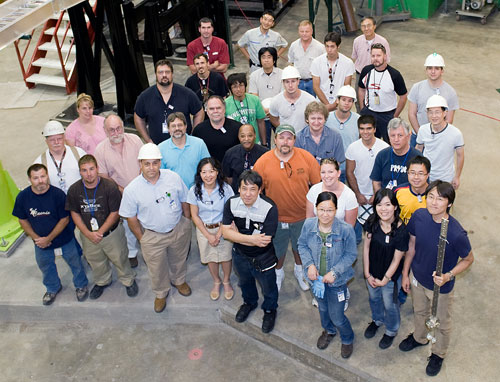
The High Resolution Electron Spectrometer (teal and red, top left) was recently built with a grant from Japan's Ministry of Education, Culture, Sports, Science and Technology. The ministry also funded the new splitter magnet (dark green) and the High Resolution Kaon Spectrometer (purple and light green, top right).
Nuclear scientists have gone to great lengths to pry open the nucleus and peer deep inside. They've manipulated its spin, bombarded it with any number of exotic particles and subjected it to heat and pressure not seen since millionths of a second after the Big Bang.
Now the HKS collaboration is taking a different tack. Group members aim to introduce an interloper into the nucleus, hoping that the stranger can elicit new information on the force that holds the nucleus together.
The scientists have named their collaboration after a primary apparatus that was built for the experiment, called the High Resolution Kaon Spectrometer (HKS). Joerg Reinhold, an associate professor at Florida International University and a spokesperson for the HKS collaboration, recently explained how the experiment works.
"We take one of the protons out of the nucleus and put a nucleon with strange quarks in. It's called the lambda hyperon," he said.
Just like an ordinary proton or neutron, the lamda hyperon contains three quarks. But where protons and neutrons only contain two kinds of quarks, up and down quarks, the hyperon contains three: an up quark, a down quark and a strange quark.
Switching out one particle for another isn't easy. The HKS collaboration aims to do it by bombarding the nuclei of two elements - chromium and calcium - with energetic electrons from Jefferson Lab's CEBAF accelerator. These electrons slam into the up and down quarks inside the protons and neutrons of the target nuclei.
"Very occasionally, in one simple picture, it tries to kick out one of these up quarks. And the up quark tries to fly away," Reinhold said.
But the force that holds the quarks together inside protons and neutrons won't allow a single quark to fly away on its own. As the errant quark gets farther away from the other quarks, the force is stretched to its limits, exerting more energy around it to keep it bound.
"At some point, this energy is so big, that you can create a strange/anti-strange quark pair. The anti-strange quark flies away with the up quark. That is called a kaon," Reinhold explained.
Meanwhile, the new strange quark may take up residence with the up and down quarks inside the proton that lost its up quark, thus transforming the proton into a lambda hyperon.
Since the hyperon is now embedded in the nucleus, the experimenters can't measure it directly. But they can measure the aftermath of this messy transformation. The High Resolution Kaon Spectrometer measures the kaon, and a newly built High Resolution Electron Spectrometer picks up the electron that struck the up quark and started the transformation. In addition, a special splitter magnet ensures that the electrons and kaons of interest are directed into the HKS and HES detectors.

The HKS collaboration in Hall C
Measuring the momentum of the kaons and electrons allows the scientists to infer the missing momentum, and thus the mass, of the new hyperon-bearing nucleus they have just produced.
"By measuring the mass of the hypernucleus, we know what the binding energy is. It tells us directly about the nuclear force," Reinhold said.
The experimenters are also excited about the prospect of applying their result to models of neutron stars.
"You have strange nucleons, lambdas or sigmas or cascades, they are called, inside a neutron star," Reinhold explained. "One of the goals of this experiment is to eventually go to heavier and heavier nuclei. You can go into a region where the models that are being used to describe neutron stars are also more applicable to nuclei."
The first run of this experiment, in 2005, used targets of carbon, boron and silicon. This run of the experiment, set to start in August and run through part of October, will explore the heavier nuclei of chromium.
Reinhold was careful to emphasize that the experiment was made possible by the time and effort of many collaborators, the work of Jefferson Lab staff, and additional equipment funding from Japan's Ministry of Education, Culture, Sports, Science and Technology. Grants from the ministry built the HKS for its first run in 2005 and the new HES and splitter magnet.
Further Reading
Hypernuclei at Jefferson Lab: http://www.jlab.org/news/releases/2006/hypernuclei.html
Tohoku University leads HKS collaboration: http://www.jlab.org/news/news_letter/2005/FebMar2005.pdf
Big Experimental Equipment - Hall C's HKS: http://www.jlab.org/news/releases/2004/04equipment_hallc.html
Technical Proposal: http://www.jlab.org/exp_prog/proposals/05/PR05-115.pdf

